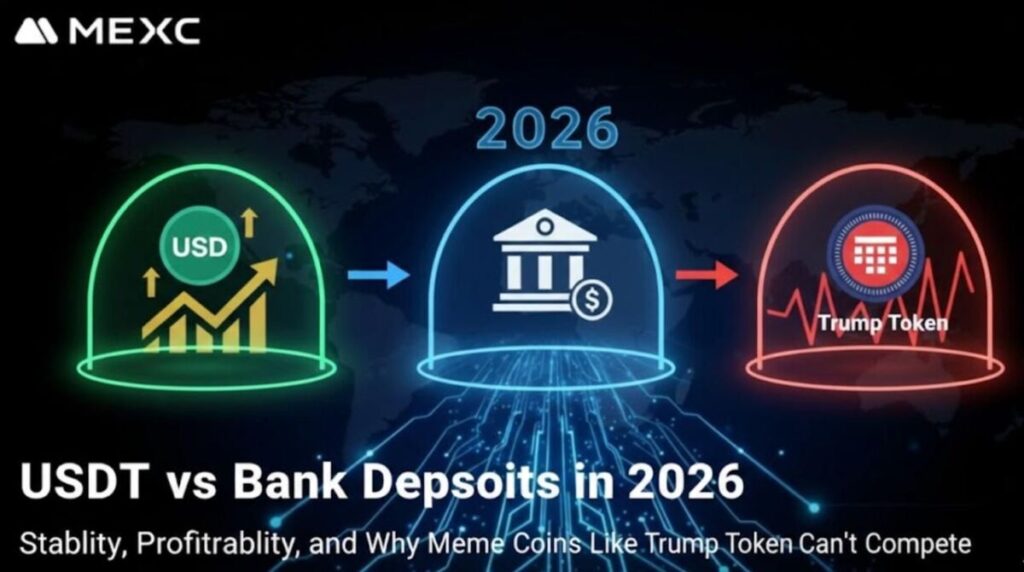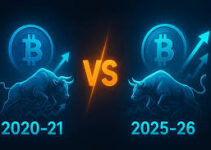
Key Takeaways
- Inflation outpaces bank yields, consider USDT: In markets with 5-8% inflation, traditional bank deposits provide negative real returns, while USDT helps preserve value with USD stability.
- Opt for higher yields with USDT staking: When bank yields hover at 1-3%, USDT offers 4-8% APY, delivering stronger real returns, even in inflationary environments.
- USDT provides 24/7 global liquidity: Unlike traditional banks, USDT offers instant global transfers, allowing flexibility for cross-border transactions and responding to currency pressures.
- USDT is core financial infrastructure: Used as a hedge against inflation and a USD exposure tool, USDT is increasingly crucial in emerging markets for wealth preservation.
Introduction
In the face of global economic uncertainties, including inflation, currency devaluation, and geopolitical instability, traditional bank deposits are being challenged by newer financial products, such as stablecoins like USDT (Tether). USDT has gained significant traction as an alternative asset that offers many benefits over traditional savings options, especially in countries struggling with high inflation and unstable economies. This article delves into the comparison between USDT and bank deposits, drawing insights from the International Monetary Fund (IMF), Chainalysis data, and global stablecoin statistics. We will also analyze the market structure, risks associated with both USDT and traditional bank deposits, and examine why USDT is becoming an essential infrastructure for wealth preservation.
1.Macroeconomic Context: Persistent Inflation and Negative Real Yields
1.1 IMF Inflation Dataset: The Global Inflation Landscape
According to the IMF’s World Economic Outlook (October 2025), inflation continues to be a significant concern, especially in emerging markets. While developed economies like the United States and the Euro Area have inflation around 2.7% and 2.1%, respectively, inflation remains much higher in many developing nations. For instance, Argentina is projected to experience 40-45% inflation in 2025, making traditional bank deposits largely ineffective for wealth preservation. The stark contrast between high inflation and low deposit yields results in negative real returns, diminishing savings. In such environments, USDT offers a stable alternative, providing USD exposure and higher yields for better wealth preservation.
This data is critical for understanding how inflation impacts savings. As the IMF’s inflation dataset reveals, the real return on savings accounts, even those insured by governments, is becoming increasingly negative in high‑inflation regions. In such areas, interest rates are too low to keep up with inflation, leading to negative real returns. For example, in Argentina, where inflation is projected to reach 40-45% in 2025, local savings accounts offer negligible yields, causing rapid depreciation in the value of saved money. USDT, a USD‑pegged stablecoin, provides an effective way to hedge against inflation and earn higher returns, making it a more reliable wealth preservation option in volatile economies.
1.2 Why this matters in USDT vs. Bank Deposits
For savers in high‑inflation regions, traditional bank deposits become increasingly ineffective, as negative real returns erode wealth. By contrast, USDT offers an inflation‑hedging solution that not only preserves purchasing power but also provides higher yields, making it a better alternative in these environments.
1.3 Chainalysis 2025 Global Crypto Adoption Index: Stablecoins Driving Grassroots Growth
The Chainalysis Global Crypto Adoption Index 2025 reveals shows high‑inflation and volatile currency economies increasingly turning to USDT for wealth preservation. India leads adoption through youth-led and P2P trading, while the United States ranks #2, driven by institutional investments. Asia-Pacific shows the fastest growth, with on-chain volume increasing by 69% YoY to $2.36 trillion. In regions like Argentina, Kenya, and Nigeria, USDT is a stable alternative to local banks, which offer minimal returns and face currency devaluation. In high‑inflation economies, where local currencies lose value quickly, USDT—pegged to the US Dollar—preserves purchasing power, offers higher returns, and is accessible via centralized and decentralized platforms. In contrast, traditional bank deposits in Argentina, where inflation exceeds 40%, offer negligible yields, while USDT provides a reliable store of value and 4-8% APY, making it a better option for wealth preservation.
The number of stablecoin transactions has increased over the years. Full Report: Chainalysis 2025 Global Crypto Adoption Index
The increasing adoption of USDT globally is a clear indicator that stablecoins are becoming an integral part of the financial ecosystem, especially in regions with volatile currencies. The inflation-hedging properties of USDT make it essential for individuals in emerging markets to preserve their wealth and gain access to the global financial system without the restrictions of local banking systems.
1.4 Stablecoin Market Structure: Maturity and Dominance
As of November 2025, the stablecoin market capitalization has surpassed $300 billion, with USDT maintaining a 60% market share (~$176 –183 billion circulating supply). The stablecoin market has matured significantly, with USDT dominating in terms of both volume and usage.
2.Stability and Transparency of USDT
USDT’s stability is maintained by the reserves that back it. According to the latest Q3 2025 attestation by BDO, USDT is fully backed by reserves, with $181 billion in reserves supporting $174 billion in liabilities, along with $6.8 billion in excess reserves. This ensures the peg to the US Dollar remains stable, even during periods of market fluctuation. The backing assets primarily consist of U.S. Treasuries, cash equivalents, and secured loans, providing a high degree of security. USDT also has a track record of maintaining its peg with rare, brief de‑pegs, and users can verify its backing via quarterly attestations and Proof of Reserves (PoR).
2.1 Why this matters in USDT vs. Bank Deposits
Unlike traditional savings accounts, which are exposed to local economic fluctuations, USDT offers a USD‑backed, stable store of value that is less prone to currency devaluation. Its transparent reserves and regular attestations also provide a level of security and reliability that bank deposits in high‑inflation regions can’t match.
Users can verify the backing of USDT by checking its quarterly attestations and Proof of Reserves (PoR).
Tether Transparency: USDT Transparency
2.2 Safety Comparison: Bank Deposits vs. USDT Holdings
| Aspect | Traditional USD Bank Deposits | USDT Holdings (on Trusted Platforms) |
| Backing/Insurance | FDIC/SIPC up to $250,000 (government-backed) | Private reserves + quarterly attestations + exchange PoR |
| Key Risks | Inflation/currency erosion; rare bank failure | Issuer transparency; platform security; regulatory shifts |
| Historical Peg/Failure Rate | Near-zero failures in regulated jurisdictions | Peg maintained since 2014; minor transient de-pegs |
| Best For | Low-inflation, developed markets | High-inflation/emerging markets; global access |
While bank deposits offer the security of government-backed insurance, USDT provides a unique solution for people in high-inflation or currency-depreciating regions. For example, individuals in Venezuela or Zimbabwe, where local currency devaluation is rampant, can use USDT to store their wealth in a stable asset without losing value to inflation.
2.3 Yield Comparison: In-Depth Analysis of Bank Deposits vs. USDT Holdings
When comparing the yield potential of traditional bank deposits and USDT holdings, it is essential to understand their performance in different economic environments.
2.4 Traditional Bank Deposits: Low Returns and Inflation Erosion
Bank deposits are considered low‑risk, but the returns are often too low to keep up with inflation. For instance, in the United States, high‑yield savings accounts offer 4.5% to 5.0% APY in late 2025. However, with 2.7% inflation, the real return is only +1.8% to +2.3%. In Eurozone countries, where inflation is around 2.1%, savings rates of 1.5% to 3.5% result in marginal or negative real returns. In high‑inflation regions like Argentina, where inflation exceeds 40%, even nominal savings rates of under 10% fail to keep up, leading to significant wealth erosion. In contrast, USDT offers competitive APY rates (typically 4-8%), making it a more reliable store of wealth in high‑inflation environments.
2.5 USDT: Higher Yields and Inflation Protection
USDT, as a stablecoin pegged to the US Dollar, provides higher returns compared to traditional savings accounts, especially in inflationary environments. In countries with low‑inflation (e.g., the United States), USDT offers 4-6% APY, while in high‑inflation regions like Argentina or Kenya, USDT remains a positive return asset despite high inflation, outperforming local savings accounts. By offering greater liquidity, global access, and higher yields, USDT provides a practical alternative to traditional savings.
3.Risks and Mitigation
3.1 Bank Risks
Traditional bank deposits are generally safe, but they are not immune to certain risks.
3.2 Inflation Risk
Bank deposits offer limited protection against inflation. In high-inflation economies, the interest rates on bank accounts often fail to outpace inflation, leading to negative real returns. For instance, in Argentina, inflation is projected to exceed 40% in 2025, and local bank savings rates simply cannot keep up with inflation. As a result, savers are losing money in real terms.
3.3 Currency Devaluation
In countries suffering from currency devaluation, savings in local currency are at risk. A country’s central bank might inflate its currency to meet budgetary demands, leading to a loss of value. Even in developed economies, currencies are subject to fluctuations against other assets like the US Dollar, affecting the purchasing power of deposits.
To mitigate these risks, savers in high-inflation regions can turn to USDT as a stable and profitable alternative form of wealth preservation.
3.4 USDT Risks
While USDT offers several advantages, it also carries some risks. These risks are generally low but should be understood and mitigated.
3.5 Issuer Default Risk
Although Tether maintains a robust reserve backing and consistently meets its peg to the USD, there is a small risk that the company could face financial difficulties or regulatory pressure, which might affect its ability to maintain its peg. USDT’s reserves are regularly audited, and excess reserves add a layer of protection against issuer risk.
3.6 Platform Risks
USDT is typically held on crypto exchanges or DeFi platforms. These platforms can be vulnerable to hacking, fraud, or regulatory crackdowns. To mitigate platform risk, users should always choose PoR-verified platforms, like MEXC, which use cold storage to safeguard funds.
3.7 Regulatory Risk
Stablecoins like USDT are facing increasing regulatory scrutiny. Governments are debating how to regulate cryptocurrencies and stablecoins to ensure financial stability and prevent misuse. USDT users should stay informed about regulatory changes in their country and globally to mitigate the risk of regulatory interventions.
3.8 Mitigation of USDT Risks
To mitigate USDT risks, users should:
- Use PoR-verified platforms: Platforms like MEXC that provide Proof of Reserves ensure that USDT is backed by sufficient reserves, offering peace of mind to users.
- Store assets in cold storage: Keeping USDT in cold storage wallets reduces the risk of hacks and platform failures, providing an additional layer of security.
- Stay updated on regulatory developments: Since stablecoins are under scrutiny by regulators, users should stay informed about regulatory developments and adjust their holdings accordingly.
4.How to buy USDT and How to earn passive income by USDT
For users in high-inflation countries where banking systems are unstable, the most accessible way to obtain USDT is through MEXC P2P— a 0-fee marketplace supporting dozens of local payment methods.
Once purchased, users can use USDT in their MEXC spot tradingor advanced futures trading or transfer it to external wallets for long-term holding.
Users seeking stable passive income can subscribe to MEXC Earn’s flexible USDT products, typically offering 15–600% APY with daily payouts and instant redemption.
5.Conclusion
In low‑inflation developed economies, FDIC‑insured bank deposits remain the preferred option for capital preservation. However, in high‑inflation regions, USDT provides a more effective alternative by offering USD exposure, higher yields, and global liquidity, particularly where traditional banks fail to provide sufficient protection. The increasing adoption of USDT, especially in emerging markets, reflects its growing importance as a financial tool for inflation hedging, wealth preservation, and global access. For those in regions facing currency devaluation or hyperinflation, USDT offers a more reliable way to preserve wealth and even grow savings compared to traditional bank deposits.
Recommend Readings:
- Discover MEXC Earn Products: https://www.mexc.com/staking
- Learn more about Futures Earn: https://www.mexc.com/learn/article/what-is-mexc-futures-earn-/1
- Generate passive income by holding MX Tokens: https://www.mexc.com/learn/article/how-to-earn-passive-income-by-holding-mx/1
FAQ
- What is USDT and how does it work? USDT (Tether) is a stablecoin pegged to the US Dollar. It is designed to maintain a stable value, typically 1 USDT = 1 USD. It functions on the blockchain, allowing fast, cheap, and transparent transactions while offering the stability of the US Dollar without the limitations of traditional banking systems.
- Is USDT safe to hold? USDT is generally considered safe as it is fully backed by reserves, and Tether provides quarterly attestations to ensure transparency. However, risks such as platform security and regulatory changes exist, which can be mitigated by using platforms with Proof of Reserves and cold storage solutions like MEXC.
- How does USDT compare to traditional bank deposits in terms of profitability? USDT offers higher returns, especially in high‑inflation economies. For example, while traditional savings accounts may offer low interest rates that fail to outpace inflation, USDT can provide yields of 4‑10% APY. In emerging markets, USDT is an effective hedge against inflation and devaluation, allowing savers to preserve and grow wealth more effectively than traditional accounts.
- Can I use USDT globally? Yes! One of the main benefits of USDT is its global liquidity. As a blockchain-based asset, USDT can be transferred and accessed 24/7, globally, bypassing the constraints of local banking hours and geographical limitations, which traditional banking systems cannot offer.
- What are the risks of holding USDT? While USDT offers significant advantages, risks include potential issuer default, platform security issues, and regulatory uncertainty. However, these risks can be mitigated by using PoR-verified exchanges and cold storage solutions.
- How is USDT different from other cryptocurrencies? Unlike more volatile cryptocurrencies like Bitcoin or Ethereum, USDT is a stablecoin that is pegged to the US Dollar. This makes it less volatile and a more reliable store of value in uncertain economic climates, providing both stability and liquidity for users.
- Is USDT a good investment in high‑inflation countries? Yes. In high‑inflation countries like Argentina and Russia, USDT offers a safe haven by providing USD exposure, higher yields than local savings accounts, and protection from currency devaluation. By holding USDT, individuals in these regions can preserve the value of their savings and even grow their wealth.
- What if the market crashes?
Your USDT stays $1. No volatility unless you trade.
Join MEXC and Get up to $10,000 Bonus!
Sign Up


